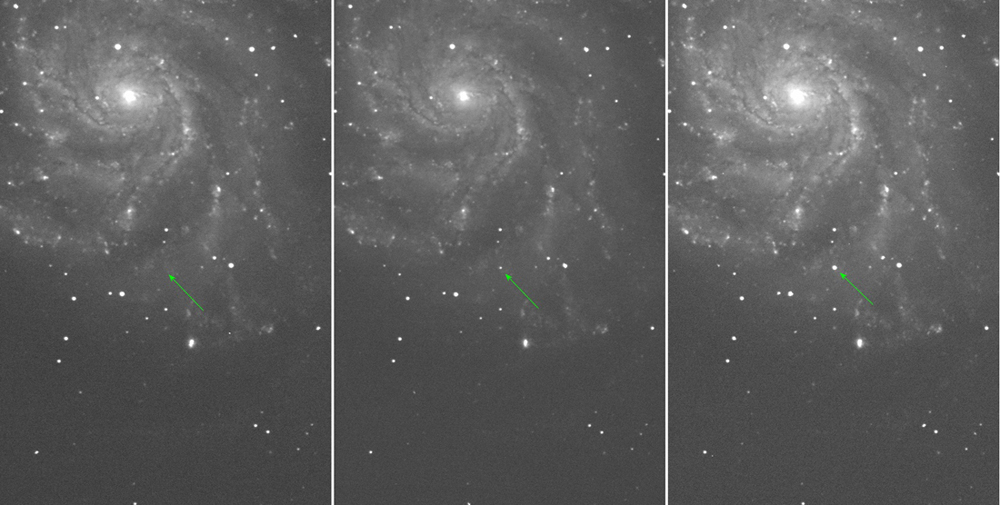Closest Supernova in 25 Years Is a 'Cosmic Classic,' Astronomers Say

Astronomers have spotted the closest supernova in a generation — and in a week or so, stargazers with a good pair of binoculars might be able to see it, too.
The supernova, or exploded star, flared up Tuesday night (Aug. 23) in the Pinwheel Galaxy, just 21 million light-years from Earth. It's the closest star explosion of its type observed since 1986, and astronomers around the world are already scrambling to train their instruments on it.
Researchers said they think they caught the supernova, named PTF 11kly, within hours of its explosion. [Photo of the new supernova PTF 11kly]
"PTF 11kly is getting brighter by the minute. It’s already 20 times brighter than it was yesterday," Peter Nugent, of the Lawrence Berkeley National Laboratory and the University of California, Berkeley, said in a statement yesterday (Aug. 25).
"Observing PTF 11kly unfold should be a wild ride," added Nugent, who was the first person to spot the supernova. "It is an instant cosmic classic."
Peering at the Big Dipper
The supernova was discovered using the Palomar Transient Factory survey, which employs a robotic telescope at Palomar Observatory in Southern California. [Photos of Great Supernova Explosions]
Get the Space.com Newsletter
Breaking space news, the latest updates on rocket launches, skywatching events and more!
The survey spotted PTF 11kly blazing up in the Big Dipper, otherwise known as the constellation Ursa Major. It is a Type Ia supernova. These explosions are thought to occur when a dying star called a white dwarf exceeds its weight limit (by accreting mass from a stellar companion, or merging with another white dwarf) and goes boom.
"Type Ia supernovae are the kind we use to measure the expansion of the universe," said Mark Sullivan of Oxford University, who was among the first scientists to follow up on the supernova detection. "Seeing one explode so close by allows us to study these events in unprecedented detail."
A rare skywatching treat
Researchers will be watching the supernova evolve over the next couple of weeks. Catching it so early in its formation and evolution is a rare treat, researchers said.
"We are finding new clues to solving the mystery of the origin of these supernovae that has perplexed us for 70 years," said Andrew Howell of UC Santa Barbara. "Despite looking at thousands of supernovae, I’ve never seen anything like this before."
This is the closest Type Ia supernova astronomers have observed since 1986, researchers said. And it's getting brighter by the day. Soon, it may even be bright enough to see with binoculars.
"The best time to see this exploding star will be just after evening twilight in the Northern Hemisphere in a week or so," Sullivan said. "You’ll need dark skies and a good pair of binoculars, although a small telescope would be even better."
Follow SPACE.com for the latest in space science and exploration news on Twitter @Spacedotcom and on Facebook.
Join our Space Forums to keep talking space on the latest missions, night sky and more! And if you have a news tip, correction or comment, let us know at: community@space.com.

Space.com is the premier source of space exploration, innovation and astronomy news, chronicling (and celebrating) humanity's ongoing expansion across the final frontier. Originally founded in 1999, Space.com is, and always has been, the passion of writers and editors who are space fans and also trained journalists. Our current news team consists of Editor-in-Chief Tariq Malik; Editor Hanneke Weitering, Senior Space Writer Mike Wall; Senior Writer Meghan Bartels; Senior Writer Chelsea Gohd, Senior Writer Tereza Pultarova and Staff Writer Alexander Cox, focusing on e-commerce. Senior Producer Steve Spaleta oversees our space videos, with Diana Whitcroft as our Social Media Editor.









